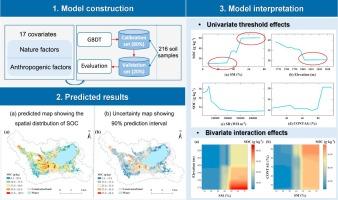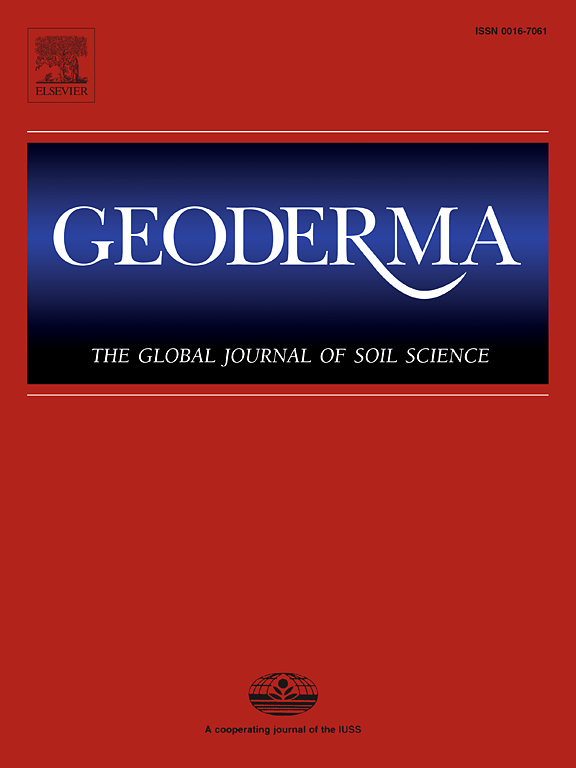揭示环境变量对高原流域土壤有机碳分布的临界效应和交互效应
IF 5.6
1区 农林科学
Q1 SOIL SCIENCE
引用次数: 0
摘要
了解土壤有机碳(SOC)的空间分布和驱动机制对于评估土壤碳储量和在农业景观中实施有效的固碳战略至关重要。环境变量与土壤有机碳之间的线性和非线性关系已被广泛记录,但多种协变量对土壤有机碳的临界效应和交互效应仍未得到充分探索。本研究以中国云南省杞麓湖流域的农田为研究对象,该流域地表条件复杂,受到气候变化和人为活动的双重影响。本研究利用该流域的 216 个土壤样本,旨在研究环境变量对 SOC 的阈值效应和交互效应。为此,研究人员采用梯度提升决策树(GBDT)结合部分隶属度分析来阐明 SOC 的空间分布以及环境因素与 SOC 之间错综复杂的关系。为了提高 SOC 预测的准确性,我们采用了景观指标作为环境变量,从而有助于更全面地描述景观。结果表明,GBDT(R2 = 0.47)优于随机森林(R2 = 0.38),获得了更高的准确性和更低的不确定性,表现为更小的 90% 预测区间。SOC 分布主要受土壤湿度、海拔高度和传染指数(CONTAG)的影响,在土壤湿度水平相对较高(50%)、CONTAG 水平(85%)和海拔相对较低(1812 米)时观察到阈值效应。此外,一个环境变量与 SOC 之间的非线性关系可能会受到另一个环境变量的影响,这表明两者之间存在交互作用,而不是简单的相加效应。我们的研究结果表明,将 GBDT 模型与部分依赖性分析相结合,为 SOC 绘图提供了一种高效且可解释的方法。了解阈值效应和交互效应对于理解环境变量与 SOC 之间的复杂关系至关重要,这对土壤碳管理具有重要意义。本文章由计算机程序翻译,如有差异,请以英文原文为准。

Unraveling the threshold and interaction effects of environmental variables on soil organic carbon mapping in plateau watershed
Understanding the spatial distribution and mechanisms driving soil organic carbon (SOC) is crucial for assessing soil carbon stocks and implementing effective carbon sequestration strategies in agricultural landscapes. The linear and nonlinear relationships between environmental variables and SOC have been extensively documented, but the threshold and interaction effects among multiple covariates on SOC remain underexplored. This study focused on farmland within the Qilu Lake watershed in Yunnan Province, China, which is characterized by complex surface conditions shaped by both climate change and anthropogenic activities. Utilizing 216 soil samples from the watershed, this research aimed to investigate the threshold and interaction effects of environmental variables on SOC. To achieve this, gradient boosted decision tree (GBDT) combined with partial dependence analysis were employed to elucidate the spatial distribution of SOC and the intricate relationships between environmental factors and SOC. In order to enhance the accuracy of SOC prediction, we employed the landscape metrics as environmental variables, thereby facilitating a more comprehensive description of the landscape. The results indicated that GBDT (R2 = 0.47) outperformed random forest (R2 = 0.38), achieving higher accuracy and lower uncertainty, indicated by a narrower 90% prediction interval. The SOC distribution was predominantly influenced by soil moisture, elevation, and the contagion index (CONTAG), with threshold effects observed at relatively high soil moisture levels (>50%), CONTAG levels (>85%), and relatively low elevations (<1812 m). Moreover, the nonlinear relationship between one environmental variable and SOC could be influenced by another, suggesting interaction effects rather than a simple additive effect. Our findings suggest that combining GBDT modeling with partial dependence analysis provides an efficient and interpretable approach for SOC mapping. Knowledge of the threshold and interaction effects is critical for understanding the complex relationships between environmental variables and SOC, which has important implications for soil carbon management.
求助全文
通过发布文献求助,成功后即可免费获取论文全文。
去求助
来源期刊

Geoderma
农林科学-土壤科学
CiteScore
11.80
自引率
6.60%
发文量
597
审稿时长
58 days
期刊介绍:
Geoderma - the global journal of soil science - welcomes authors, readers and soil research from all parts of the world, encourages worldwide soil studies, and embraces all aspects of soil science and its associated pedagogy. The journal particularly welcomes interdisciplinary work focusing on dynamic soil processes and functions across space and time.
 求助内容:
求助内容: 应助结果提醒方式:
应助结果提醒方式:


